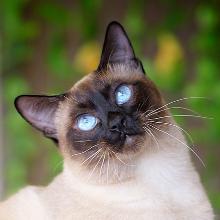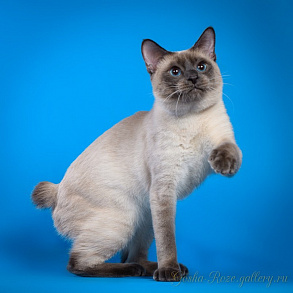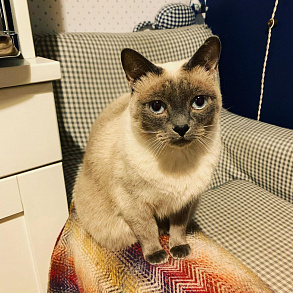Mekong Bobtail

The Mekong Bobtail is an indigenous breed of cats from Southeast Asia. The pet is distinguished by a calm affectionate disposition and devotion.
Brief information
- Breed Name: Mekong Bobtail
- Country of Origin: Southeast Asia
Highlights
- Mekong bobtails are balanced, very sociable and intelligent cats, capable of becoming ideal companions.
- The breed has a number of "canine" habits, which attracts many buyers.
- The cat gets attached to the owners, loves communication and tactile contact.
- The Mekong Bobtail feels great as a single pet, at the same time it gets along well with cats and dogs. By virtue of instincts, bobtail will definitely open a hunt for rodent, bird or fish.
- Representatives of the breed get along well with babies and do not show aggression, so they are suitable for families with children.
- Mekong bobtails are long–lived. With proper care, cats are able to please you with their company for a quarter of a century or even more, while they retain the ability to reproduce almost until the end of their lives.
Mekong Bobtail - short-haired and short-tailed cat. An elegant strong animal has a friendly character. An inquisitive pet becomes attached to all family members, gets along well with children, taking on the duties of a "caretaker of the house". Despite its exotic appearance, the Mekong bobtail does not require complex care and is distinguished by good health.
History of the Mekong Bobtail breed
Southeast Asia has become the birthplace of the Mekong bobtails. The breed was named after the Mekong River, which flows on the territory of Thailand, Myanmar, Cambodia, Laos, Vietnam. The word "bobtail" means the presence of a short tail. Initially, cats were called Siamese, then Thai, and only in 2003 they were called Mekong to avoid confusion with other breeds. One of the first descriptions of these cats belonged to Charles Darwin, who mentioned them in 1883 in the work "Changing domestic animals and cultivated plants".
At home, the breed was considered royal. Thai bobtails lived on the territory of temples and palaces. For a long time, protecting the breed, the Thais prohibited the export of cats. Mekong bobtails left the country extremely rarely and only as especially valuable gifts. Among the recipients were Nicholas II, the British ambassador Owen Gould and Anna Crawford, the governess of the Siamese king's children. The breed came to Europe in 1884, to America in the 1890s.
There was a legend that Thai bobtails accompanied their noble owners even in the baths – the princesses left rings and bracelets on the twisted tails of cats during bath procedures. According to other legends, these pets were assigned to guard sacred vases in temples. From the efforts made, the bobtail tails twirled, and the eyes became slightly slanted.
For a long time the breed remained unnoticed, being considered a variety siamese cat . For this reason, breeding was carried out for a long time along the way of culling individuals with short twisted tails. This trait has not been lost only thanks to individual fans of Thai bobtails. Later, professional felinologists noted a significant difference in the physique, the setting of the ears, not to mention the naturally short tails.
Systematic breeding breeders engaged only in the XX century. Russian breeders made a special contribution to the development of the breed. Olga Sergeevna Mironova proposed the first standard at the WCF 1994 meeting in St. Petersburg. In 1998, the requirements were adjusted at a meeting of the ICEV. In Russia, the final recognition of the breed took place in 2003 with the participation of the WCF commission. In 2004, the name was approved internationally, the Mekong bobtail was indexed by MW. Crossing with other breeds is considered unacceptable, therefore, individuals exported from Asia are actively used for breeding.
Video: Mekong Bobtail
Appearance of the Mekong bobtail
Mekong bobtails are medium–sized shorthair animals of color point color. Cats are much larger than cats, their weight is 3.5-4 kg and 2.5-3 kg, respectively. A distinctive feature of the bobtail is a short tail in the form of a tassel or a pompom. Puberty is reached by 5-6 months.
Head
Has rounded, slightly elongated contours and an average length. The cheekbones are high, and the smooth transition of the "Roman" nose is below eye level. The muzzle is oval, without a stop in the vibrissus area. The chin is strong, located on the same vertical with the nose lobe. In males, the cheekbones look wider largely due to the additional skin.
Eyes
Large, oval with almost straight delivery. In Mekong bobtails, only the blue eye color is allowed – the brighter, the better.
Ears
Large, have a wide base and rounded tips, slightly tilted forward. With a high postage, the outer edge is slightly pulled back. The intermediate distance should be less than the lower ear width.
Body
Elegant, muscular, rectangular shape. The back is almost straight, and the increase towards the croup is insignificant.
Legs
Medium height, slim.
Paws
Are small, have a clear oval outline. On the hind limbs, the claws do not retract, therefore, when walking, they can emit a characteristic clatter.
Tail
The tail of the Mekong bobtails is movable, with a fracture at the base. This is a unique combination of knots, hooks, and creases for each animal. Length – not less than 3 vertebrae, but not more than ¼ of the body. Preferably, the presence of a "pouch" at the tip.
Wool
Shiny and short, close to the body and at the same time crumbly. The undercoat is minimal. The skin around the body loosely fits the muscles, elastic (especially on the neck, back, cheeks).
Color
All point colors with clear borders are allowed. The mask does not go to the back of the head and necessarily captures the pads of the vibrissae. There are no spots on the light belly. Kittens are born light, and the point manifests itself with age, but white color in adults is not acceptable.
The classic color of the Mekong bobtail is considered to be seal point or Siamese - the coat is from light cream to light brown, with dark brown areas around the paws, ears, tail and muzzle. Red point is recognized as the rarest - such cats have apricot fur, and the limbs and muzzle are reddish. Tortoiseshell and chocolate bobtails, as well as blue and tabby Point color pets are also in demand.
Character of the Mekong Bobtail
Cats of the Mekong Bobtail breed are very inquisitive, so get ready for the fact that the pet will follow you everywhere, accompany you in all household chores, sleep in bed. Sociable animals make a lot of amazing purring and cooing sounds, commenting on their own actions and responding to the owner's remarks. At the same time, they are quite restrained, do not allow themselves a violent display of feelings. Representatives of this breed like to communicate with him, often pronouncing his name.
Mekong cats have "canine" habits: they like to carry things in their teeth, they are happy to execute the command "Aport!", they always run to inspect and sniff the guest. In the case of forced self-defense, they bite more often than they use claws. But because of the peaceful nature, forcing a pet to defend itself is not so easy. The Mekong Bobtail is patient with young children. These are devoted creatures who become attached to all family members and feel the mood of the owner well.
The breed easily gets along with other pets if they are also friendly. But before you start fish, birds or rodents at the same time, you should think carefully, because cats have an incredibly strong hunting instinct. Mekong bobtails tolerate trips in cars well, but each animal can have its own "speed limit", in case of exceeding which the cat begins to meow loudly, informing the driver of discomfort. If you often drive in a car, it is worth accustoming your pet to this method of transportation as early as possible.
If you acquire two animals of different sexes, the cat will take over the leadership of the pair. She will closely monitor that the cat performs parental duties: accustomed offspring to complementary foods, scratching post, tray, licked them. In such a situation, the owner practically does not have to deal with these issues.
It is not necessary to lock the animal in a separate room. The Mekong bobtail is perfect for keeping in any family, it can be safely called a fluffy companion. The pet does not tolerate prolonged loneliness, which must be taken into account when deciding to have a cat.
Care and maintenance
The Mekong bobtail is extremely simple in content. Its short smooth coat has practically no undercoat, molting goes unnoticed. It is enough to comb the pet with a soft massage brush once a week. It is worth buying a cat a scratching post, but on the hind legs you can trim the claws manually. It is necessary to carry out the procedure very carefully so as not to damage the vessels located nearby.
For the prevention of tartar, you can give bobtail special solid feed. Bathing is optional for this breed, but some cats like water. Bath procedures should be carried out no more than twice a month. In case of wool contamination, veterinary wet wipes can be an alternative. Mekong cats are clean, usually do not mark the territory, easily get used to walking on a leash or the shoulder of the owner. In the cold season, you should not abuse air baths – bobtails are thermophilic.
The diet should be balanced. It can consist of natural products or premium feed. It is not recommended to give milk, liver, pork, cabbage, beetroot, cod and pollock, food "from the table". Choosing a natural diet, take care of the availability of vegetables and cereals in the menu (15-20% of the diet). Lean meat and dairy products are allowed. Once a week, you can please your pet with a quail egg or fish. In general, Mekong bobtails are not picky in terms of nutrition. The breed is not prone to obesity, it is enough to feed an adult animal twice a day, providing access to clean water.
Health and diseases of the Mekong bobtail
The breed is in good health, so it is usually enough to inspect the ears, eyes and teeth of a pet once a week. Periodic deworming and scheduled vaccination are also required. Mekong bobtails live about 20-25 years with proper care. The oldest cat of this breed is 38 years old.
Sometimes animals suffer from gingivitis, rhinotracheitis, chlamydia, microsporia, calcivirosis. In old age, some individuals develop arthritis or kidney failure, and in the absence of care, teeth fall out.
How to choose a kitten
The Mekong Bobtail is not a very popular breed, so it is important to take seriously the choice of a nursery. You may have to take a queue for a kitten. Mekong bobtails are born almost white, and the point areas begin to manifest by 3 months. It is during this period that the kids are ready to move to a new home. Finally, the color should be formed by the end of the first year of life. The kitten should be playful, with clear eyes, shiny fur and a good appetite. Also, the breeder is obliged to provide documents for the pet: a veterinary passport, a metric or a pedigree.
How much does the Mekong bobtail cost
You can buy an exhibition kitten of the Mekong bobtail for about $300 - $500. Cats are usually more expensive than cats. The price largely depends on the title of the parents. A pet with external signs of the breed, but without documents, is easy to buy much cheaper – from $50. Also, it is usually inexpensive to give individuals that are considered culling: white, with too long or short tail.


